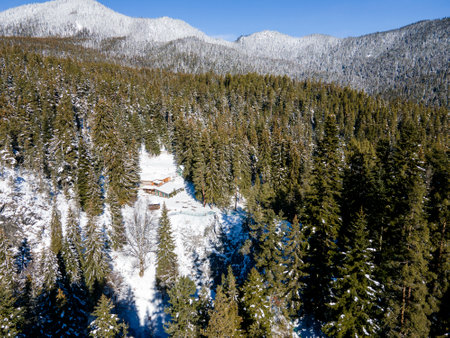1. Prepare for Extreme Winter Conditions
Know What Youre Up Against
Winter camping in the U.S. is a whole different ball game compared to summer trips. Snow, ice, freezing temperatures, and unpredictable storms can turn a fun adventure into a real challenge if youre not prepared. Understanding what you might face out there helps you follow Leave No Trace principles and keeps both you and the wilderness safe.
Check the Weather Forecasts
Before you head out, always check reliable weather sources like the National Weather Service or local forecasts. Weather in the mountains or remote areas can change fast. Knowing what’s coming helps you plan better and avoid dangerous situations.
Popular Weather Resources
| Resource | Website/App |
|---|---|
| National Weather Service | weather.gov |
| The Weather Channel | weather.com / App Store & Google Play |
| NOAA Weather Radio | Physical radio device |
| Local Outdoor Outfitters | In-store/local websites |
Pack the Right Gear for Winter Camping
Packing for winter is all about safety, warmth, and being able to leave no trace. You’ll need more than just a sleeping bag and tent—think layers, snow stakes, insulated pads, and a sturdy stove that works in cold weather.
Essential Winter Camping Gear Checklist
| Item | Why Its Important |
|---|---|
| Four-season tent | Stands up to wind and heavy snow; prevents damage to fragile environments by staying put. |
| Synthetic or down sleeping bag (rated for low temps) | Keeps you warm and safe from hypothermia. |
| Insulated sleeping pad(s) | Adds crucial warmth between you and the frozen ground. |
| Layered clothing (base/mid/outer) | Makes it easy to adjust for changing temps without sweating (which can be dangerous in cold weather). |
| Stove & fuel suitable for cold conditions | Cooks food fast and melts snow for water; liquid-fuel stoves work best below freezing. |
| Trekking poles/snowshoes/microspikes | Aids in safe travel over snow and ice without damaging trails. |
| Headlamp with extra batteries | Days are shorter—always have light available. |
| Navigational tools (map, compass, GPS) | Avoids getting lost when trails are covered in snow. |
Plan Safe Routes and Minimize Risks
Select your campsite and routes carefully. Avoid avalanche-prone slopes, unstable ice, or areas near tree wells (deep pockets of loose snow around tree trunks). Stick to established trails where possible—this protects sensitive habitats hidden under snow cover.
Quick Tips for Safer Winter Camping Routes
- Avoid steep slopes above 30 degrees (avalanche risk).
- Stay clear of riverbanks—they may be unstable or hiding thin ice.
- If traveling in groups, keep visual contact at all times in snowy terrain.
- Mark your route with brightly colored flags or tape if visibility drops.
Your Responsibility Outdoors
The first step to practicing Leave No Trace in winter is preparing yourself for whatever Mother Nature throws at you. By planning ahead, packing smart, and knowing your limits, you help protect wild places—and everyone gets home safely to tell the story!
2. Travel and Camp on Durable Snow Surfaces
When winter camping, it’s important to protect nature by choosing where you walk and set up camp wisely. The snow may look harmless, but what’s underneath is often delicate plants or sensitive soil that can be easily damaged. By following the Leave No Trace principle of traveling and camping on durable surfaces, you help keep these ecosystems healthy for future campers and wildlife.
Why Deep Snow and Frozen Ground Matter
Deep snow and frozen ground act like a natural shield for the earth below. When you walk or camp on these surfaces, you spread out your weight so you’re less likely to crush plants or disrupt animal habitats. If you step off established trails or pick spots with little snow, your boots and gear can press down into the ground, leaving lasting marks that might not heal until the next growing season—or even longer.
Tips for Minimizing Impact
| Do | Don’t |
|---|---|
| Use packed, established trails whenever possible | Wander off into untouched meadows or forest floors |
| Set up camp on deep snow (at least 6 inches thick) | Camp directly on exposed vegetation or thin snow cover |
| Choose areas that look already impacted if snow is thin | Create new campsites in pristine areas |
| Move tents and gear around to avoid creating icy patches | Leave equipment in one spot for too long on soft snow |
Remember:
If you see obvious signs of plant life poking through the snow, move to a spot with deeper coverage. The goal is always to leave things just as you found them—or better!
![]()
3. Dispose of Waste Responsibly
When winter camping, keeping the outdoors clean is just as important—if not more—than during the warmer months. Snow can make it tempting to hide trash or waste, but everything left behind eventually melts out and can harm the environment or wildlife. Following Leave No Trace principles means packing out all your trash, leftover food, and even human waste using winter-appropriate methods.
Pack Out All Trash
All wrappers, food scraps, and packaging should be packed back out with you. Even biodegradable items like orange peels or apple cores can take years to break down in cold environments and may attract wildlife. Bring sturdy bags or containers that can withstand freezing temperatures and won’t rip easily.
Managing Human Waste in Winter
Disposing of human waste responsibly in winter conditions takes some planning. It’s often not possible—or ethical—to dig a cathole in frozen ground or deep snow. Instead, use specialized gear designed for these situations:
| Method | Description | Best For |
|---|---|---|
| Wag Bags (or similar) | Seal human waste in double-layered, odor-proof bags designed for easy carry-out. | Short trips or areas where digging is impossible. |
| Personal Portable Toilets | Small, portable toilet systems that contain waste until proper disposal. | Larger groups, base camps, or longer stays. |
Winter Tips for Packing Out Waste
- Keep a dedicated “trash bag” inside your pack so you always have it handy.
- If using wag bags, store them outside your tent overnight to avoid odors inside but keep them protected from animals.
- Avoid leaving any kind of waste—even used tissues or hygiene products—in the snow.
The Bottom Line
Packing out all waste keeps the wilderness pristine for everyone and protects fragile winter ecosystems. With the right preparation and gear, it’s easy to follow Leave No Trace principles—even when the ground is covered in snow.
4. Minimize Campfire Impact
When winter camping, it’s important to protect the snowy environment and local wildlife by minimizing your campfire impact. While a cozy fire may seem inviting, building one in the snow can leave lasting scars on the landscape and use up limited wood resources. Instead, plan ahead and rely on camp stoves for all your cooking needs.
Why Choose Camp Stoves Over Campfires?
| Camp Stoves | Campfires |
|---|---|
| Leave no permanent marks in the snow | Can melt and scar snowy or icy ground |
| Do not disturb local vegetation or habitats | Require collecting wood, which affects ecosystems |
| Safe and easy to control | Can get out of hand or smolder under snow layers |
| Quick setup and cleanup | Need to be completely extinguished and dismantled |
Tips for Responsible Cooking in Winter Campsites
- Bring a reliable camp stove: Make sure your stove works well in cold temperatures and bring extra fuel just in case.
- Avoid collecting firewood: In snowy areas, downed wood is often home to small animals or insects, and removing it can harm their habitat.
- Set up your cooking area safely: Choose a flat spot away from tents and pack out all trash and food scraps.
- If you must build a fire: Only do so where fires are permitted, use an established fire ring if available, keep fires small, and scatter cool ashes when done.
Remember:
Your actions have a big impact on winter wilderness. By using a camp stove instead of building a fire, you help preserve the beauty of snowy landscapes for everyone to enjoy.
5. Respect Wildlife and Other Visitors
When winter camping, it’s important to remember that you are sharing the outdoors with both wildlife and other adventurers. Respecting their space helps keep nature wild and ensures everyone has a positive experience.
Observe Wildlife from a Distance
Winter is a tough season for animals. They’re often using all their energy just to stay warm and find food. Getting too close can stress them out or even put their survival at risk. Always use binoculars or a camera with a zoom lens if you want a closer look. Give animals plenty of space, and never chase or try to touch them.
Avoid Feeding Animals
Feeding wildlife might seem harmless, but it can actually do more harm than good. Human food isn’t healthy for animals, and feeding them can make them dependent on people or even aggressive. Keep your food packed away securely so animals aren’t tempted to sneak into your campsite.
| Do | Don’t |
|---|---|
| Watch wildlife quietly from afar | Approach or try to pet animals |
| Store food in animal-proof containers | Leave snacks or trash outside |
| Use binoculars for viewing | Feed animals, even birds or squirrels |
Keep Noise Levels Down
The quiet beauty of a snowy landscape is part of what makes winter camping special. Loud noises can scare off wildlife and disturb other campers who are there to enjoy the peace and solitude. Talk quietly, avoid playing music on speakers, and keep group activities low-key so everyone can appreciate the calm environment.
Tips for Respecting Others and Wildlife:
- Camp away from established animal trails and water sources
- Let others pass on trails and greet them with a friendly wave or hello
- If you bring pets, keep them leashed and under control at all times
- Follow posted rules about fires, noise, and campsite boundaries
Your Role in Protecting the Outdoors
By observing these simple guidelines, you help protect wildlife during their most vulnerable season and make winter camping enjoyable for everyone who shares the trail with you.


